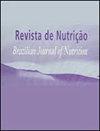肠内营养治疗晚期癌症患者的生存率:热量估算的比较
IF 0.5
4区 医学
Q4 NUTRITION & DIETETICS
Revista De Nutricao-brazilian Journal of Nutrition
Pub Date : 2022-01-01
DOI:10.1590/1678-9865202235e210054
引用次数: 0
摘要
【摘要】目的探讨肠内营养治疗中热量估算的实现及晚期癌症姑息治疗患者生存的相关因素。方法回顾性研究,将2019年3月至2020年2月入院的使用肠内营养的患者分为两组:第一组包括达到预期热量目标75%的患者,第二组包括未达到预期热量目标75%的患者。这些数据是从患者的电子病历中提取的。采用Logistic回归分析来评估所研究的社会人口学、临床和营养变量之间的相关性,并采用Kaplan-Meier曲线和Cox回归来评估各组的生存率。结果共158例患者参与研究,中位年龄63岁(智商55 ~ 70岁)。57%达到热量目标(第一组)。在logistic回归中,功能容量(OR: 5.82;置信区间:2.28—-14.84;p<0.001)和恶心或呕吐症状(or: 0.050;置信区间:0.005—-0.455;P =0.008)是实现热量目标的独立变量。Cox回归显示Karnofsky Performance Status是生存的独立预测因子(HR: 1.85;置信区间:1.13—-3.04)。结论功能较好的患者生存期较长,是达到国家和国际癌症患者指南所提出的热量目标的潜在候选人。本文章由计算机程序翻译,如有差异,请以英文原文为准。
Survival of patients with advanced cancer in Enteral Nutritional Therapy: a comparison between caloric estimates
ABSTRACT Objective To assess factors related to the achievement of the caloric estimates of enteral nutritional therapy and the survival of patients with advanced cancer in exclusively palliative care. Methods Retrospective study, where patients using enteral nutrition admitted from March 2019 to February 2020 were divided into two groups: Group 1 included patients who reached 75% of the estimated caloric goals, and Group 2 included those who did not. The data were extracted from the patients’ electronic medical records. Logistic regression analyzes were performed to assess associations between the studied sociodemographic, clinical, and nutritional variables, and the Kaplan-Meier curve and Cox regression were used to assess the survival of the groups. Results A total of 158 patients participated in the study, with a median age of 63 (IIQ: 55-70) years. 57% reached the caloric goal (Group 1). In the logistic regression, the functional capacity (OR: 5.82; CI: 2.28-14.84; p<0.001) and symptoms of nausea or vomiting (OR: 0.050; CI: 0.005-0.455; p=0.008) were independent variables for achieving the caloric goal. Cox regression showed Karnofsky Performance Status as an independent predictor for survival (HR: 1.85; CI: 1.13-3.04). Conclusion Patients with better functionality have longer survival and are potential candidates for reaching the caloric goals proposed by national and international guidelines for cancer patients.
求助全文
通过发布文献求助,成功后即可免费获取论文全文。
去求助
来源期刊
CiteScore
1.20
自引率
12.50%
发文量
24
审稿时长
6-12 weeks
期刊介绍:
Revista de Nutrição is former Revista de Nutrição da Puccamp, founded in 1988. It is a bimonthly publication every four months and it is of responsibility of the Centro de Ciências da Vida, da Pontifícia Universidade Católica de Campinas . It publishes articles that contribute to the study of Nutrition in its many sub-areas and interfaces; and is open to contributions of the national and international scientific communities.

 求助内容:
求助内容: 应助结果提醒方式:
应助结果提醒方式:


